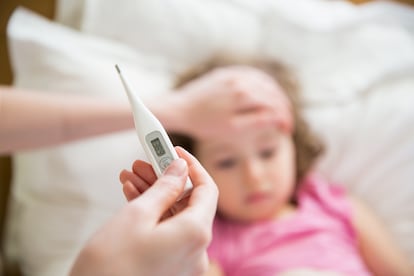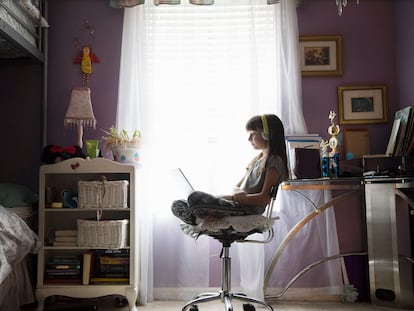A child’s fever: you have to treat the discomfort instead of worrying about the numbers on the thermometer
Running a fever isn’t always dangerous for children. On the contrary, a fever is a key defense mechanism against infections. Therefore, if a child feels well, pediatricians recommend not administering antipyretics

“The fever won’t go down” is the phrase that pediatricians hear the most during their professional practice. In humans, a fever means running a temperature of 100.4°F or more. This condition has always been the workhorse of children’s health, as well as a headache of mothers and fathers.
Despite being a fundamental part of our defense system against infections, lowering fever is often considered the goal to beat, even if it requires a prescription. But that trend is changing. Today, most specialists in children’s health insist that fevers shouldn’t always be lowered at all costs. Rather, treating the discomfort that fevers may cause in boys and girls should be the priority.
“It’s the most frequent reason [why parents] come to the emergency room,” says Paula Vázquez López, president of the Spanish Society of Pediatric Emergencies (SEUP). “A fever doesn’t cause brain damage, or death, or anything. It’s good [when a child] has a fever, because it’s our body’s way of defending itself against viruses and bacteria,” adds this pediatric emergency specialist, who practices at the Gregorio Marañón Hospital in Madrid.”Even having a high fever – or one that doesn’t go down – doesn’t mean that the infection is more or less important,” she explains to parents. “I’ll give you an example: the flu is a viral infection that causes a very high fever, lasts several days and is very difficult to bring down… but it’s not serious.”
According to Juan Carlos Molina – a pediatrician in the emergency department of the Niño Jesús Children’s Hospital, also in Madrid – our parents and grandparents accepted fevers as being natural. But now, there is “feverphobia – a misdirected or meaningless fear,” the specialist sighs. “Parents often want to treat the thermometer; they’re concerned about much more than [their child’s] general condition. I tell them that the goal is for them to be well – if we give them antipyretics, it’s so that the child is more comfortable.”
Indeed, fever serves “to help us activate our body’s defenses,” as the Spanish Association of Primary Care Pediatrics (AEPap) explains on its website. By itself, this scientific society emphasizes, “a fever doesn’t cause damage to neurons. The complications – if there are any – are due to the cause of the fever, not to the fever itself.” In a downloadable brochure by AEPap aimed at families, the recommendations offered coincide with the advice of the pediatricians consulted by this newspaper: “You only have to use medicines for fever if there is discomfort or pain.”
Additionally, the document clarifies that “neither the degree of fever nor the response to treatment guides [doctors] regarding the severity of the infection, or whether it’s caused by viruses or bacteria.” The AEPap insists on hydrating adequately and not covering or undressing the child too much. The association also advises against household measures such as “the use of damp cloths, alcohol scrubs, showers, or baths. Treatment of fever does not modify the evolution of the infection. The important thing is the treatment of the infection that causes it,” the experts emphasize.
“You have to change the [idea] that you have to lower a fever based on the number that the thermometer shows; instead, you have to do it according to how the child feels,” Vázquez López emphasizes. It’s also unnecessary to use medicines to prevent reactions to vaccines, such as fever, or inflammation in the area of the puncture. “I’m old and I remember how, in the past, every time I got vaccinated as a child, [the doctors would tell my parents]: in case she gets a fever, give her [paracetamol] to prevent it. But it’s now clear that this wasn’t correct.”
What good does a fever do?
Strictly speaking, we consider a body temperature that’s over 99.5°F to be a fever, or pyrexia (from the word pyros, which means “fire” in Greek). However, anything between 98.6°F and 100.4°F is usually classified as being a “low-grade fever.” Under normal conditions, the thermoregulatory center of the hypothalamus keeps us at between 95°F and 98.6°F, which is the ideal range for smooth physiological functions. However, certain substances act as pyrogens: they stimulate this thermostat at the base of the brain to raise the temperature, which “decreases the reproduction of microbes and increases the inflammatory response,” as described on the Hospital Clínic de Barcelona’s website. “When there’s a fever, the immune defenses and the mobility of the leukocytes improve. Products that are more toxic to the bacteria are generated,” Molina explains.
Pyrogens can be exogenous substances (such as microbes and their toxins) or endogenous (molecules that our immune system uses to communicate, such as cytokines or prostaglandins). When leukocytes detect the pyrogens of a germ that infects us (which, in children, are usually viruses), they release cytokines into the blood, which alert the biological thermostat to raise the temperature. This is achieved by increasing metabolism, reducing blood flow to the skin – which causes palor and feeling cold – and producing muscle contractions, or the classic shivering. Once the hypothalamic thermostat returns to the normal range, the body feels hot and sweats to reduce the temperature, which explains the various symptoms of febrile syndrome.
Measurement of temperature should be made with an electronic contact thermometer, Molina advises. “Ear thermometers and infrared ones – which you put on the forehead – aren’t very reliable.” In older children, the axillary (armpit) measurement is sufficient… but in children under the age of one, temperature should be taken via the rectum. “The rectal temperature is between 0.5°C and 1°C higher than the axillary one, but closer to the real one,” this expert notes. Precision, he clarifies, is necessary in young infants – especially in children under three months – because the risk of serious infections increases. Additional tests may be required, although these are rarely done in older children who are in good physical condition.
At one point does a problem arise? As Molina explains, temperatures above 105°F are more dangerous, especially if they are maintained. “But in these cases, there’s talk of hyperthermia… in children, it’s very rare. It [usually] occurs due to significant exposure to the sun, such as heat stroke, or poisoning from certain medications,” the pediatrician clarifies.
Unfounded fears of fever-induced seizures
“Another thing that scares mothers and fathers are seizures,” explains Vázquez López. Indeed, a small group of infants and young children (about 4%) have a genetic predisposition to seizures that accompany fever. But the AEPap insists that lowering these children’s temperatures early on doesn’t help to prevent seizures. And while pediatric assessment is always recommended after a seizure in the context of fever, “[parents shouldn’t] insist on lowering it so that [seizures] don’t happen,” reiterates the president of the SEUP. “In most cases, you don’t have to do anything – they last for a few seconds. [These kinds of seizures] disappear with age, because the brain matures. There’s no need to take any medication to prevent febrile seizures,” the specialist affirms.
“Not all children are going to have them, even if they have a very high fever,” Molina adds. “There’s a genetic predisposition [to febrile seizures]. Oftentimes, the patients have already experienced this.” The pediatrician acknowledges that some children “end up having epilepsy when they’re older, but it’s very rare, around 1% or 2%.”
In any case, “it’s very difficult to avoid these seizures – [parents shouldn’t bother] administering antipyretics or applying cold compresses. There’s no need to apply a different treatment to these children…. they should receive [the same treatment] as kids who aren’t prone to febrile seizures.”
The usual medications for children with fever and malaise are paracetamol – which is analgesic and antipyretic – and ibuprofen, which is also anti-inflammatory. These medications don’t cure the infection, but they do help the child feel better. “When the fever is due to significant inflammation – such as acute otitis media (ear infections) or adenitis (swollen lymph glands) – I prefer ibuprofen,” Molina says. “But for temperature control, both are the same.” While the practice of alternating or combining these medicines is widespread, there is no evidence that this is more effective, as stated in a review published in the Spanish journal Evidence in Pediatrics. In fact, doing so increases the risk of dosing confusion and the risk of side effects.
“Many doctors recommend [this], but it hasn’t been shown to be more effective in reversing fever and it leads to errors, either due to overdosing or underdosing. One must be given [these medicines] on schedule… the doses can be raised a little or the administration intervals can be shortened, but it’s not appropriate to combine one and the other sequentially.” Vázquez López explains it to parents this way: “Sometimes, I tell them that, occasionally, they can give the alternative medication, but the ibuprofen-paracetamol-ibuprofen-paracetamol regimen is totally discouraged. Many times, it’s the pediatricians themselves who set this pattern, but alternating must be avoided.”
Nor are traditional remedies a good idea, such as putting children in cold or warm water. “Instead of promoting the well-being of the child, [these practices] prioritize discomfort. And, if they work, [the results are] very temporary – we don’t recommend them,” Molina emphasizes. Sometimes, parents turn to less common practices, such as rubbing their feverish child with alcohol. “This is dangerous, because it burns and irritates the skin a lot; rubbing alcohol can also be absorbed, intoxicating the child.”
Sometimes, parents overdress their kids. “With several shirts, it’s more difficult to lose heat. We tell parents that they should put light clothes on their children and place them in a cool, well-ventilated place. They can drink liquids, but putting them in the bathtub is outdated.”
Sign up for our weekly newsletter to get more English-language news coverage from EL PAÍS USA Edition
Tu suscripción se está usando en otro dispositivo
¿Quieres añadir otro usuario a tu suscripción?
Si continúas leyendo en este dispositivo, no se podrá leer en el otro.
FlechaTu suscripción se está usando en otro dispositivo y solo puedes acceder a EL PAÍS desde un dispositivo a la vez.
Si quieres compartir tu cuenta, cambia tu suscripción a la modalidad Premium, así podrás añadir otro usuario. Cada uno accederá con su propia cuenta de email, lo que os permitirá personalizar vuestra experiencia en EL PAÍS.
¿Tienes una suscripción de empresa? Accede aquí para contratar más cuentas.
En el caso de no saber quién está usando tu cuenta, te recomendamos cambiar tu contraseña aquí.
Si decides continuar compartiendo tu cuenta, este mensaje se mostrará en tu dispositivo y en el de la otra persona que está usando tu cuenta de forma indefinida, afectando a tu experiencia de lectura. Puedes consultar aquí los términos y condiciones de la suscripción digital.
More information
Últimas noticias
NASA discovers Titan doesn’t have an ocean, but a ‘slushy ice layer’ that increases possibility of life
Innocence lost in the forest of the child soldiers: ‘Each leader of the armed group had his girls’
‘Fallout’ or how the world’s largest company turned an anti-capitalist apocalyptic Western into a phenomenon
From inflation to defending migrants: Eileen Higgins and Zohran Mamdani inaugurate the new Democratic resistance against Trump
Most viewed
- ‘El Limones’ and the growing union disguise of Mexican organized crime
- Christian Louboutin: ‘Young people don’t want to be like their parents. And if their parents wear sneakers, they’re going to look for something else’
- The low-cost creative revolution: How technology is making art accessible to everyone
- A mountaineer, accused of manslaughter for the death of his partner during a climb: He silenced his phone and refused a helicopter rescue
- Liset Menéndez de la Prida, neuroscientist: ‘It’s not normal to constantly seek pleasure; it’s important to be bored, to be calm’











































